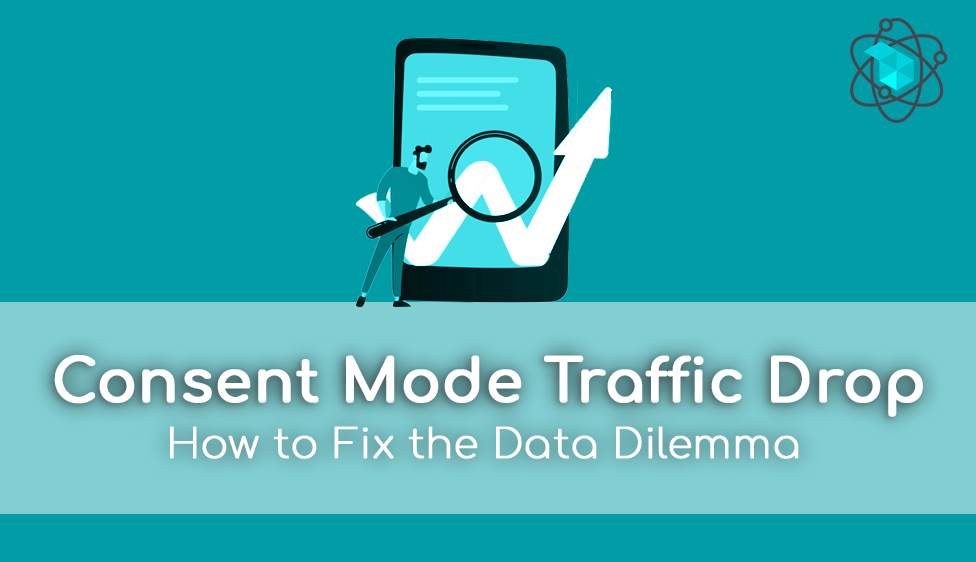Ever hoped for a bit of calm after implementing Consent Mode V2?

Well, in the fast-paced world of advertising, tranquillity is about as common as spotting a unicorn. As the philosopher Arthur Schopenhauer famously quipped, “the two foes of human happiness are pain and boredom”.
But let’s be real, boredom – in advertising? Non-existent.
It’s a constant whirlwind of activity, never a dull moment. But let’s cut the theatrics and get down to business, especially when facing the challenges of the Consent Mode traffic drop.
THE EVIDENCE BEHIND CONSENT MODE TRAFFIC DROP
Let’s start with the basics: life in advertising is dangerous, yes, we heard you. “We’re all in this together” (if you’re singing the High School Musical song now, you had a nice and sweet childhood. Well you might have had a good one even in the other case but come one – there’s no comparison).
Also, as you know, we’re data-driven-and-dangerous. Like life in advertising, but in a good way. This to say, we had to provide scientific evidence of what we’re talking about. Accounts implementing Consent Mode witnessed:
- A drop in traffic ranging from 40% to a jaw-dropping 90%, when implemented alongside a cookie banner
- Modelling taking a leisurely stroll into reports, with some reports playing hard to get for up to 20 days
Considerations:
- A 40% to 70% organic drop is expected, with higher drops possibly linked to factors like brand trust for each specific market
- Some accounts fail to meet Google’s requirements for Consent Mode data integration into GA4 reports
WHAT IS THAT SUPPOSED TO MEAN?

Let’s decode the jargon. What’s the deal with advertisers experiencing severe performance drops in ROAS, Conversions, CPA, and AdSpend post-Consent Mode V2 implementation?
Switching to Consent Mode disrupts the flow of data to Analytics and Advertising platforms, leaving campaigns in a state of shock. Each campaign, much like each session with ChatGPT, is unique and starts collecting data afresh. So, when the data faucet suddenly changes course, confusion ensues. It’s like algorithms are having an existential crisis:
- Is it my fault?
- Did things change dramatically?
- Shall I lower that bid?
In a nutshell, it’s like flipping the script on campaigns, but instead of tweaking external factors like budget or targets, we’re messing with the very fabric of data streams and experiencing the repercussions of the Consent Mode traffic drop.
A NECESSARY DETOUR
We could simply provide a link and call it a day, but where’s the fun in that? We prefer to take a more scenic route, much like Virgil guiding Dante through the circles of Hell (wow, we went pretty hard on that!) As performance marketing experts, we’re committed to ensuring you understand every step of the journey.

So, let’s delve into Google’s prerequisites for Consent Mode data integration:
- Ensure Consent Mode is activated across all pages of your websites or all app screens
- Implement Consent Mode for web pages so that tags load before the consent dialog appears, ensuring Google tags load in all instances, not just when the user consents (advanced implementation)
- Your property should collect a minimum of 1,000 events per day with analytics_storage=’denied’ for at least 7 days
- Ensure you have at least 1,000 daily users sending events with analytics_storage=’granted’ for at least 7 of the previous 28 days
- Note that meeting the data threshold within the specified timeframe may take more than 7 days, and additional data may still not be sufficient for Analytics to train the model effectively
Navigating these prerequisites is crucial for addressing the challenges posed by the Consent Mode traffic drop.
HELLO CONSENT MODE TRAFFIC DROP
You implemented Consent Mode, and suddenly, traffic and performance are on a downward spiral. You’re nodding in agreement, feeling the frustration. We’re not claiming clairvoyance here; it’s just a matter of analysing the data. We rely on data for everything, even stocking our headquarters’ cereal supply – talk about being prepared for any scenario.
Where were we? Ah, yes, the drop in tracked data. Two scenarios unfold:
- Scenario 1: It’s a waiting game. After the time it takes for machine learning to track data, accounts return to their pre-implementation traffic levels. No need to panic; just give it time. After all, Rome wasn’t built in a day.
In this scenario, two burning questions arise:
1) How long does it take for data to bounce back?
Answer: It varies, depending on the volumes of the website where Consent Mode was implemented. Typically, it ranges from 7 to 20 days
2) Are there any metrics that remain different from before?
Answer: Yes, new user metrics tend to recover more slowly than other metrics
- Scenario 2: The drop persists, signalling a deeper issue. This happens when accounts fail to adhere to Google’s requirements.
FIX TO SCENARIO NUMBER ONE
Fixing time? Not exactly possible, but hey, good things come to those who wait, right? So, grab a coffee, binge-watch a show, and relax. The Consent Mode traffic drop will work out eventually.
Feeling sceptical? No worries – piece of cake (sorry for making your stomach growl, our bad). Just get in touch, and we’ll provide reassurance. Easy peasy.
FIX TO SCENARIO NUMBER TWO
Yass, the wait is over. The much-awaited solutions to your dilemmas are finally here (well, those regarding Consent Mode traffic drop of course – we’re nerds, not the Cumaean Sibyl).
So, what are the options to solve this?
- Export data in BigQuery:
Dive into the sample data retrieved by Consent Mode to understand why your modelling isn’t working as expected
(Keep in mind, though, that this export might incur some costs if you don’t have it enabled. Reach out to us for clarification) - Analyse user behaviour with our banner script + CRO:
Our custom script delves into how users interact with your banner, providing insightful analysis. Based on this data, we can offer feedback to enhance your banner and drive users towards the “accept all” option. Sounds too good to be true? It’s the real deal. - Utilise offline imports:
Integrate events and information seamlessly to mitigate the impact of Consent Mode. - Assess Consent Mode implementation:
Take a closer look at how Consent Mode is implemented across your platforms. Or maybe just ask us to do so. - Set up a Server-to-Server tracking implementation:
Enable Server-to-Server tracking to send data and disable ad personalization and ad_user_data - Explore analytics alternatives:
But that’s a story for another time. However, if you’re keen to explore different analytics options, reach out to us
Did you notice that for chapter six, we’ve prepared six different solutions?
Impressive, right?
Wait – did you really notice that? Shall we swap stories about our OCDs?
SO, SO WHAT?
I’m still a rockstar, I got my rock moves…

… sorry, we got carried away by rock and roll 🤘🎸
You might still feel a bit confused, or maybe you simply can’t be bothered. Or perhaps both. Or maybe none of the above, but you’re feeling a bit lonely 🫂 So, where do we go from here?
Well, you’ve got to start somewhere, right? Figure out what’s happening with Consent Mode traffic drop, what you need, whether you should take action now or just wait it out a bit longer. Or at the very least, have a plan ready to roll.
We reckon a consent mode assessment could give you the lowdown and help you plot your next move. Get in touch, and we’ll have you sorted in no time.

